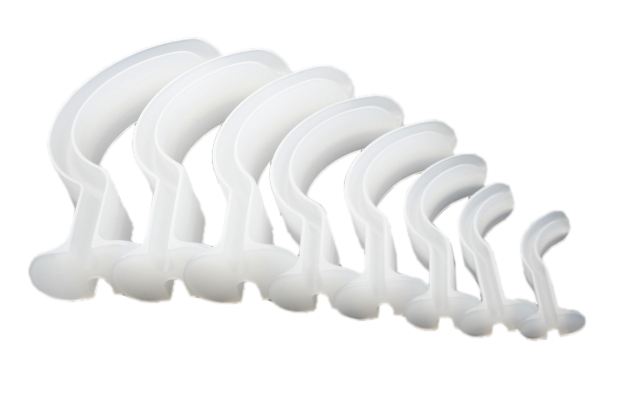Berman Airways
Berman Airways are slotted plastic tubes that are inserted into the nostrils to provide a clear airway during anesthesia. The slots in the sides of the tube permit suction catheters to be passed through without obstructing the air passage. Berman Airways are available in different sizes to fit both adults and children.
Description
- Slotted sides permit passage of suction catheters without obstructing the air passage.
| Ref. No.: |
mm: |
Size: |
Qty. Cs: |
| NMR101005 |
110 |
5 |
500 |
| NMR101004 |
100 |
4 |
500 |
| NMR101003 |
90 |
3 |
500 |
| NMR101002 |
80 |
2 |
500 |
| NMR101001 |
70 |
1 |
500 |
| NMR101010 |
60 |
0 |
500 |
| NMR101020 |
50 |
00 |
500 |
| NMR101030 |
40 |
000 |
500 |
What are Berman Airways?
Berman Airways are slotted plastic tubes that are inserted into the nostrils to provide a clear airway during anesthesia. The slots in the sides of the tube permit suction catheters to be passed through without obstructing the air passage. Berman Airways are available in different sizes to fit both adults and children.
How do Berman Airways Work?
Berman Airways are slotted tubes that allow suction catheters to pass through without obstructing the airway. This makes them ideal for use in emergency situations where suctioning of the airway may be necessary.
Pros and Cons of Berman Airways
There are pros and cons to using Berman Airways. Some people find that they are very helpful in clearing suction catheters without obstructing air passage. Others find that they can be difficult to use and may not always work as intended.
How to use Berman Airways
Berman Airways are suction catheters that have slotted sides, which permit passage of the suction catheter without obstructing the air passage. When using Berman Airways, it is important to first lubricate the suction catheter. Next, insert the Berman Airway into the mouth with the tip pointing downwards towards the back of the throat. Gently advance the Berman Airway until resistance is felt. At this point, rotate the Berman Airway 90 degrees and then continue to advance it until resistance is again felt. Finally, rotate the Berman Airway 180 degrees so that the slotted side is facing upwards and then remove it from the mouth.
Berman Airways Slotted sides permit passage of suction catheters without obstructing the air passage best Medical products from Nexgen Medical USA company-Online shipping Nationwide.
 Berman Airways, Berman Oropharyngeal Airways, Berman Oral airway, Berman Oral Airway Kits, Berman Oral Airway Kits use, Berman Oral Airway Kit online sale, Berman Oral Airway Kit price, Berman Oral Airway Kit price in India, Berman Oral Airway Kit Nexgen Medical.
Berman Airways, Berman Oropharyngeal Airways, Berman Oral airway, Berman Oral Airway Kits, Berman Oral Airway Kits use, Berman Oral Airway Kit online sale, Berman Oral Airway Kit price, Berman Oral Airway Kit price in India, Berman Oral Airway Kit Nexgen Medical.
Oral airways, which are used around the world an
estimated 350 million times annually and often in challenging situations, are a ubiquitous part of anesthesia practice. Yet as a retired professor from the Emory University School of Medicine explained, current airways have drawbacks as they are not designed to hold the jaw protruded or control the tongue from falling back.
A new airway, the Lower-Jaw-Thrusting (LJT) oral airway (Wedge Therapeutics), is designed to address these problems. As its developer explained, the novel airway prevents both the jaw and tongue from moving backward in unconscious or semiconscious patients, thereby providing what he claimed is superior airway management in these individuals (Figure).
“Every anesthesiologist uses the oral airway,” said Berman Airways, MD, Ph.D., a retired professor of anesthesiology from the Atlanta institution and professor emeritus from Basaveshwara Medical College in Chitradurga, India. “But all of them allow the jaw and tongue to fall backward and create an obstruction if you don’t manually hold the jaw protruded forward.
“I’ve been wrestling with this for a long time and have developed an oral airway that will hold the jaw and tongue forward, thereby opening the entire airway from front to back—all while freeing the hands of the practitioner,” Dr. Shantha said.
No Trauma to Oral Mucosa
As Dr. Shantha described, oropharyngeal airways largely owe their designs to Arthur Guedel’s 1933 original design and Robert Berman’s 1952 revised design. Nevertheless, the relative inability of these devices to keep the lower jaw protruding is problematic; as soon as practitioners remove their jaw-thrusting hand, the jaw and tongue fall backward.
Even more concerning,” Dr. Shantha said, “is that these current oral airways don’t employ proportional dimensional standards in relation to the buccal bite block and C-curve length—another factor that causes them to be deficient in maintaining the oropharyngeal airway.”
Considering previous research demonstrating that mandibular advancement increases the oropharynx opening under anesthesia, Dr. Shantha and his colleagues developed the LJT oral airway, which mechanically pulls the lower jaw forward and holds it in a protruded position while simultaneously preventing the flaccid tongue from moving backward. The device incorporates a mandibular flange that extends down from the bite block, which is designed to hold the mandibular incisor teeth in a protruded position.
